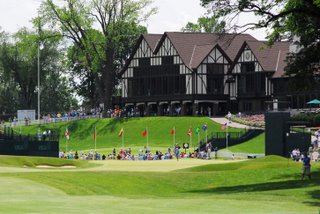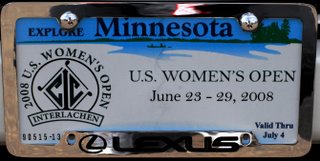
 No doubt where the courtesy cars are coming from or heading to ... (image by Susan Simpson).
No doubt where the courtesy cars are coming from or heading to ... (image by Susan Simpson).
An E-mail Postcard from US Women's Open
sent by the Ladies Golf Union's Carnoustie-born Director of Championships, Susan Simpson.
She writes:
sent by the Ladies Golf Union's Carnoustie-born Director of Championships, Susan Simpson.
She writes:
Greetings from the land of 10,000 lakes and 10 million mosquitos.
Very hot weather by our standards but locals think it is cool !! 80 degrees + and not good for the pale Scots – already looking a bright shade of red!
By the way, the first pro here at Interlaachen was Willie Kidd from Monifieth. He was Patty Berg’s teacher (member here until she died)
By the way, the first pro here at Interlaachen was Willie Kidd from Monifieth. He was Patty Berg’s teacher (member here until she died)
US Women’s Open goes to great lengths
By BRADLEY S. KLEIN
Senior Writer, GOLFWEEK
Long straight drivers of the golf ball will have a distinct advantage at this week's US Women’s Open.
Interlachen Country Club in Edina, Minnesota, home to the championship from Thursday to Sunday is the longest course to hold the US Women’s Open.
With five par-5s, four of them reachable in two by powerful hitters, the 6,789-yard, par-73 lay-out offers a potential birdie-fest to players who can control their tee shots.
At the same time, its tree-lined fairways severely punish wayward drives. In short – actually, long – it’s a typical USGA-style parkland course.
The 160-acre site is part of a spacious, leafy suburb seven miles southwest of downtown Minneapolis. The course dates to a 1911 lay-out by Willie Watson that was transformed into its current guise by Donald Ross from Dornoch in 1919.
Bobby Jones made headlines there in 1930 when he won the U.S. Open, the third leg of his Grand Slam. Interlachen subsequently held the 1935 U.S. Women’s Amateur (won by Glenna Collett Vare), the 1986 U.S. Senior Amateur (won by Bo Williams), the 1993 Walker Cup (U.S. over G.B. & I, 19-5), and the 2002 Solheim Cup (U.S. over Europe, 15 1/2-12 1/2).
Interlachen offers rolling fairways, 25-28 yards wide, that require precise shot-making if the ball is to stay in play. The greens are on the small size, averaging 5,000 square feet, with considerable pitch from back to front. Many of the greens are perched on modest plateaus and require well-struck approaches, lest the ball roll off into bunkers and chipping hollows.
The rough will be graduated, with the bulk of the primary cut at 3 inches deep. Green speeds will average 11.5-12 on the Stimpmeter – much faster than for everyday LPGA events.
There’s a twist to the normal (members') lay-out, thanks to the nines being flipped. The move places a road crossing earlier in the round, before heavy spectator traffic builds toward the back nine. More importantly, it defers the club’s most famous hole, normally the par-5 ninth, until the end, where it should provide dramatic theatre.
Both nines end on what could prove to be decisive holes. The 413-yard, par-4 ninth hole calls for a semi-blind tee shot to a landing area 30 feet below the tee. The hole plays into the prevailing westerly wind and requires a long approach to a putting surface 30 feet above the fairway.
As hard as the roly-poly fairway is to hit, the green is even more elusive – all three tiers of it.
Interlachen’s 530yd, par-5 18th hole is a fine stage for the culmination of a match. The broad, open expanse of the green provides ideal viewing.
The key to playing it is a strong tee shot that favors the right side – leaving a second shot that must carry a huge mid-fairway lake that runs to within 50 yards of the putting surface. It was here that Jones skipped his second shot across the pond on his way to a birdie.
Like many classic-era golf courses, Interlachen demands controlled shot-making. That’s never an easy matter, the more so when the fairways cant and ground beneath one’s feet is uneven, so that the ball rarely comes to rest on a level plane.
At the US Women’s Open, contestants will have to try finding their own comfort level.
Labels: Pro Ladies










<< Home